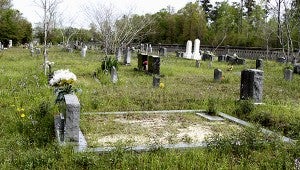The mystery of Turtleskin Cemetery
Published 7:00 am Friday, April 11, 2014

FAMILY TREASURES: Turtleskin Cemetery is the final resting place for many of Pearl River County’s oldest families. The cemetery was established prior to the existence of Pearl River County.
Jodi Marze | Picayune Item
As you drive to the John C. Stennis Space Center, you will pass a historical cemetery positioned by the north gate. The cemetery is named Turtleskin Cemetery for the Turtleskin Creek which runs behind it.
It is located at the site of the old Corinth Baptist Church. Among those laid to rest are members of many Picayune families as well as 18 graves that were reinterred from the Gainesville Cemetery by NASA in 1964.
The earliest grave on record is that of an infant Stewart from Nov. 23, 1814.
Among those buried are relatives of many local families from the Picayune and Carriere area. Names like Ladner, Frierson, McQueen, Alsobrooks, Lee and Kellar can be found on tombstones in abundance through the cemetery.
When asked how so many people from Pearl River County came to be buried in a Hancock County cemetery, Charles Gray of the Hancock Historical Society, was happy to share the answer.
Gray explained that it helps to go back to the beginning of our development as a region and a county, to get a true understanding.
He said that after the Louisiana Purchase, in 1883, the state of Mississippi part of a region known the Mississippi Territory. “The government set about to attract settlers from the North by offering free land,” Gray said. “This effort brought in 3,300 people from the states of Tennessee, Virginia and North Carolina who were primarily Anglo Saxon Protestants, who formed geographical area known as the Bible Belt.”
After state of Mississippi formed in 1817, three territories along the Gulf Coast were formed in 1818, named Hancock, Jackson and Mobile. When Alabama became a state in 1819, Mobile County was given to Alabama, Gray said.
In 1842, Hancock County was divided from north to south creating Harrison County.
In 1880, Hancock County was again divided, but this time from east to west. This division resulted in the formation of Pearl County. The county financially failed due to the lack of a major city to support it. Ten years later they re-divided Hancock County and this time formed Pearl River County.
Gray said the point is that during the time when families buried their loved ones in the Turtleskin Cemetery, everyone lived in Hancock County.
It is of interest that in the earliest recorded information of families who settled along the coast, 47 were of French Catholic faith and one family was of Spanish Catholic faith, he said.
“The Juan Cuevas family was of Spanish Catholic faith and settled on Cat Island. He married one of Nicholas Christian Ladner’s daughters,” Gray said. “ An interesting fact about Nicholas Christian Ladner is that he was arrested on Cat Island because he was mistaken for Jean Lafitte the pirate. During his arrest, he gave the name Nicholas Christian. However, all of his land and deeds were in the name of Christian Ladner.”



